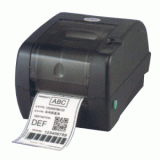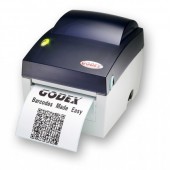Shopping Cart
0 item(s) - AED 0.00Barcode Printers

A barcode printer is a computer peripheral for printing barcode labels or tags that can be attached to physical objects. Barcode printers are commonly used to label cartons before shipment, or to label retail items with Universal Product Codes.
Desktop barcode printer has become a commonplace tool for entering product information at retail chains and shopping complexes. Industrial barcode printers are used in manufacturing facilities and large warehouses helping in inventory management and sales process automation.
The most common barcode standards are UPCs and EANs.
Universal Product Code Bar Code - The standard bar code printed on retail merchandise. It contains the vendor's identification number and the product number which is read by passing the bar code over a scanner.
European Article Numbering is the European standard for barcodes. There are two different versions of EAN bar codes, EAN-13 and EAN-8, which encode 13- and 8-digit numbers, respectively. A special EAN-13 bar code with a 5-digit supplemental code is used on books to encode the International Standard Book Number (ISBN) and the price. This bar code is called "Bookland".
Traditional one-dimensional bar codes use the bar's width to encode a product or an account number. Two-dimensional bar codes, such as PDF417, MaxiCode and DataMatrix, are scanned horizontally and vertically and hold considerably more data. PDF417 is widely used for general purposes. MaxiCode is used for high-speed sorting, and DataMatrix is used for marking small parts.
Barcode Printers employ two major printing methods - Direct Thermal (DT) and Thermal Transfer (TT).
Direct thermal printers use a print head to generate heat that causes a chemical reaction in specially designed paper that turns the paper black. Direct thermal printers are generally less expensive, but they produce labels that can become illegible if exposed to heat, direct sunlight, or chemical vapors. Barcode printers require regular cleaning of the ribbon and the print head. Specks of dust may cause distortion of the bar codes. The outputs of these printers using ANSI software need to be continuously checked in order to check for system malfunctions.
Thermal transfer printers also use heat, but instead of acting directly on the paper, the heat melts a waxy or resin substance on a ribbon that runs over the label or tag material. The heat transfers ink from the ribbon to the paper. Thermal Transfer requires the use of a heated ribbon to produce long-lasting images of data onto a label and/or tag, whereas Direct Thermal process prints the image directly on the label/tag.
Direct thermal and thermal transfer barcode printers can print bar code labels on variety of media. The range of bar code printers vary from light duty printers to rugged and high speed industrial printers for meeting diverse requirements. In industrial printers, the range varies from medium to heavy duty to extra heavy duty printers. These printers can be integrated to existing applications / ERP for on demand label/tag printing.
Industrial barcode printers are used in large warehouses and manufacturing facilities. They have large paper capacities, operate faster and have a longer service life. For retail and office environments, desktop barcode printers are most common.
Refine Search
Ex Tax: AED 849.00
.png)

